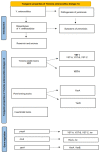Toxigenic Properties of Yersinia enterocolitica Biotype 1A
- PMID: 35202145
- PMCID: PMC8877543
- DOI: 10.3390/toxins14020118
Toxigenic Properties of Yersinia enterocolitica Biotype 1A
Abstract
Yersinia (Y.) enterocolitica, an etiological agent of yersiniosis, is a bacterium whose pathogenicity is determined, among other things, by its ability to produce toxins. The aim of this article was to present the most important toxins that are produced by biotype 1A strains of Y. enterocolitica, and to discuss their role in the pathogenesis of yersiniosis. Y. enterocolitica biotype 1A strains are able to synthesize variants of thermostable YST enterotoxin and play a key role in the pathogenesis of yersiniosis. Biotype 1A strains of Y. enterocolitica also produce Y. enterocolitica pore-forming toxins, YaxA and YaxB. These toxins form pores in the cell membrane of host target cells and cause osmotic lysis, which is of particular importance in systemic infections. Insecticidal toxin complex genes have been detected in some clinical biotype 1A strains of Y. enterocolitica. However, their role has not yet been fully elucidated. Strains belonging to biotype 1A have long been considered non-pathogenic. This view is beginning to change due to the emerging knowledge about the toxigenic potential of these bacteria and their ability to overcome the defense barriers of the host organism.
Keywords: YST-b; YSY-c; Yersinia enterocolitica; biotype 1A; insecticidal toxins; toxins.
Conflict of interest statement
The author declares no conflict of interest.
Figures




References
Publication types
MeSH terms
Substances
LinkOut - more resources
Full Text Sources

